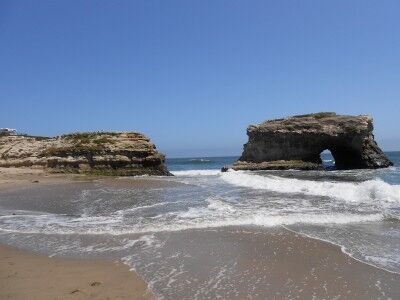If you are looking for a beach that has more than just sand, Natural Bridges State Beach (CA) is an excellent choice. In addition to Sandy Beach and the Natural Bridge, the beach also has wonderful tide-pools to explore during low tide and is home to one of the largest monarch butterfly over-wintering sites in the Western United States. The beach was named after three natural bridges that extended out into the ocean — now only one remains:


In the early 1900s, three arches carved by nature out of a mudstone cliff inspired the naming of Natural Bridges.
The arches were formed millions of years ago when water, silt and clay sediment combined with one-cell marine plants called diatoms. Heat and pressure solidified the mixture into a soft stone that formed the three arches.
Wave action against the soft rock formed the bridges and also undercut them, eventually wearing them away and leaving only islands. The outermost arch fell in the early part of the 20th century and the inner arch broke during a storm in 1980. Only the middle arch remains, but it is being slowly eroded by the waves.
With the last remaining bridge now fully cut off from the coast, it’s part of the California Coastal National Monument.

I arrived at high tide, so I was not able to explore the tide-pools. I have on other occasions in the past and they are quite interesting and an excellent place to take kids with quite a bit of tide-pool life to see.
The park rangers offer year round guided nature walks on such topics as wildflowers, birds and wetland explorations.
The monarch butterfly natural preserve walkway is currently being worked on, but should be ready when the monarch butterflies return in winter. Monarch butterfly tours are offered at 11:00 am and 2:00 pm on weekends in the fall and winter. The park also offers two special events related to the monarch butterflies: Welcome Back Monarch Day is on the second Sunday in October from 10:00 am to 4:00 pm and The Monarch Migration Festival is the second Saturday in February from 10:00 am to 4:00 pm.
